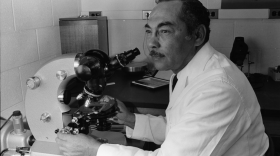In the archives at the Grand Rapids Public Library, there is a recording, made by the historian Carolyn Shapiro-Shapin in 1998.
“This is an interview with Mrs. Loney Gordon, concerning her work at the Michigan Department of Health’s Grand Rapids laboratory,” Shapiro-Shapin announces at the start of the recording, amid the hiss and click of old audio tape.
It is, it seems, the only surviving recording of Loney Clinton Gordon, a Black woman born in Arkansas in 1915, who moved to Grand Rapids and contributed to the development of a vaccine that has saved thousands of lives.

This year for Black History Month, we are bringing you stories of Black Michiganders who made contributions in medicine and science.
And as many of us wait for our turn getting a shot of a new vaccine to end a pandemic, the story of Loney Clinton Gordon is as important as ever.
Gordon was born Loney Clinton. She moved to Grand Rapids as a child. She went to South High School, and was just a few years younger than Gerald Ford. They both appear in the school’s yearbook in 1931.
In the interview, Clinton Gordon tells of how she trained to be a dietician, and graduated from Michigan State University. She had one dietician job in Virginia, but it didn’t last.
“I couldn’t take that prejudice,” she says on the recording. “They could say no to me, or I could say no to them. They said yes to me, but I said no to them. So I left.”
She came home to Grand Rapids and applied for jobs, but she says she was told some wouldn’t take orders from a Black female dietician.
That’s when she heard from Dr. Pearl Kendrick.
Kendrick and Dr. Grace Eldering had been working for almost a decade on the vaccine for the whooping cough, which is also known as pertussis. It was a deadly disease. The CDC records well over 100,000 confirmed cases per year in the 1920s and 1930s. And Shapiro-Shapin's research showed it killed an average of 6,000 children per year in the 1920s.
As Kendrick and Eldering developed the first version of their vaccine, they realized they needed to isolate a new strain of the bacteria, to make the vaccine more effective.
That’s what Kendrick hired Loney Clinton Gordon to find.
“I knew what my mission was to be,” Clinton Gordon told Shapiro-Shapin. “To help find the culture with sufficient virulence to make the vaccine.”
It was not an easy thing to do.
“You have to be expert at culturing the bacilli,” says Shapiro-Shapin, recalling the interview. “And she was someone who had that gift.”
“So this one day, I went in and I said ‘Okay God this has to be the day,'” Clinton Gordon said.
“And she tells it – it was almost like a religious experience,” Shapiro-Shapin says. “Actually she tells it very much in the way Alexander Fleming spoke about his discovery of penicillin. And it was interesting to hear her use very similar language for that.”
“It just talked to me. Here I am,” Clinton Gordon said. “And bingo, there it was.”
"There weren't any headlines," Loney Clinton Gordon said of her work on the whooping cough vaccine. "You achieved something and you were glad for that."
After this discovery, her job in Grand Rapids was done. There was an opening with the state health department in Lansing, as a microbiologist. So Gordon moved.
“And I was a supervisor and I taught – did a lot of benchwork teaching people,” Clinton Gordon said.
“And she was among, if not the first African American scientist there,” says Sharon Peters, who grew up knowing Loney Clinton Gordon. Gordon was friends with Peters mother, Helen Claytor.
Peters said her friend faced discrimination at the Lansing lab. As Gordon put it, some people were nasty.
“And Loney was not one to suffer those kind of things silently,” Peters says. “Although she had to maintain her employment. And so she, like the rest of African Americans had to walk kind of a tightrope.”
She did walk it. And made it to retirement.
In 1997, the Michigan House voted to honor her with a resolution.
Gordon held a copy of this resolution in her interview in 1998. She said she felt that she had made a definite contribution.
“But there weren't any headlines,” Clinton Gordon recalled. “I mean, that's not the way it worked. You achieved something and you were glad for that.”
Today, there is a statue of Loney Clinton Gordon in downtown Grand Rapids, along with Pearl Kendrick and Grace Eldering. They’re preserved in bronze outside of a research building where today’s scientists work on more research that could someday save lives.
Want to support reporting like this? Consider making a gift to Michigan Radio today.





